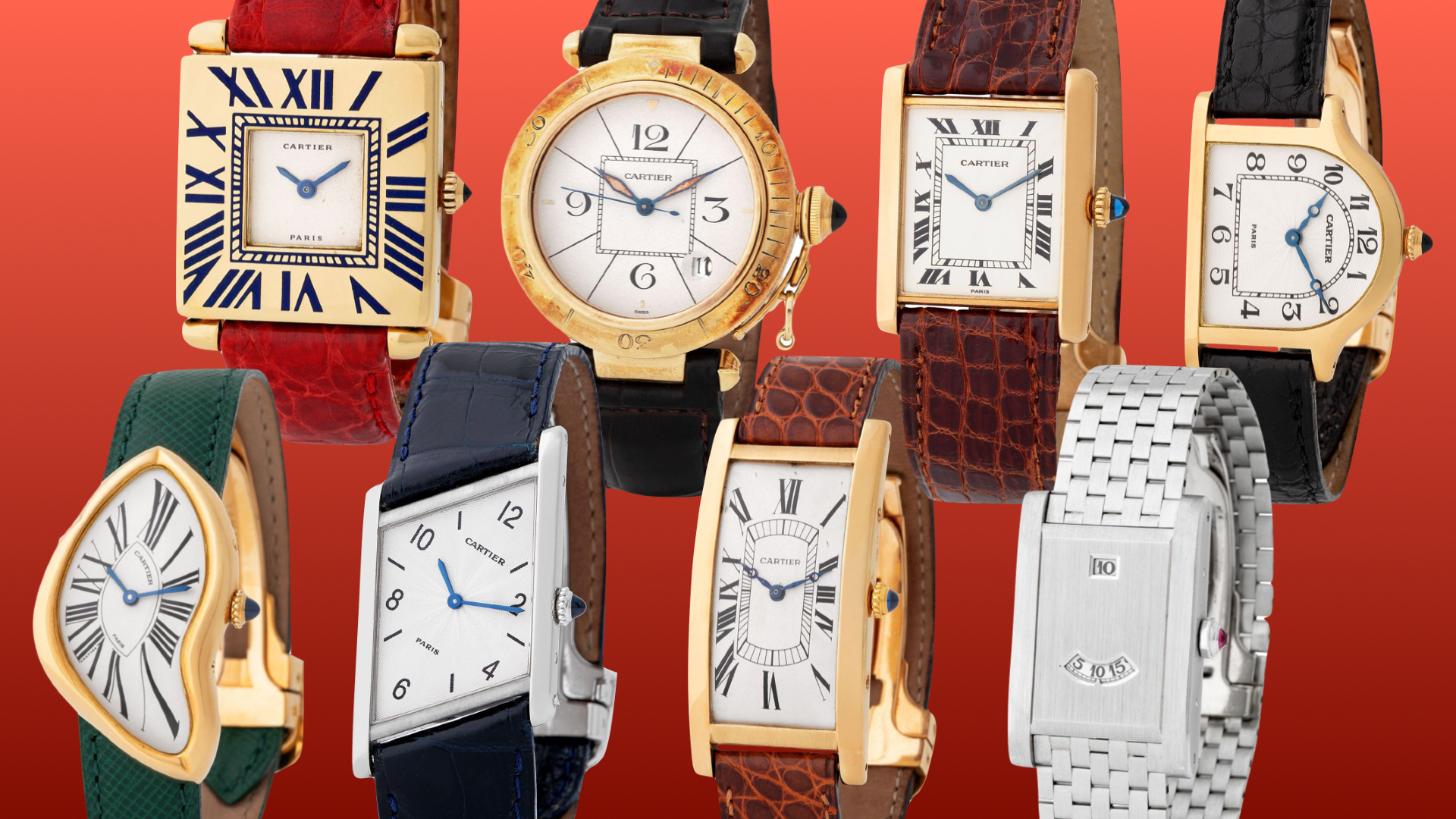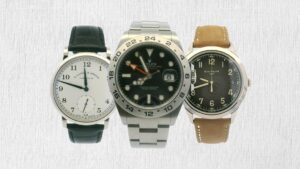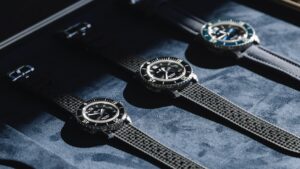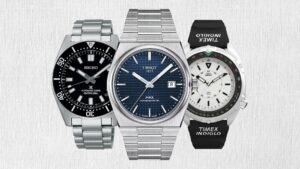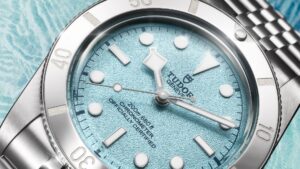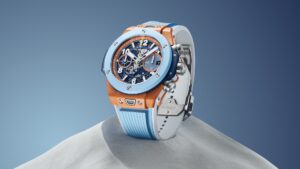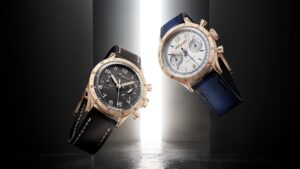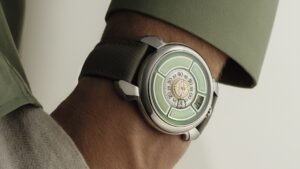It’s hard not to be a fan of Cartier if you’re into watches. From the fascinating, multi-generational history of the original Cartier family, to the project of relentless creativity that Cartier has embarked upon since its earliest days, there’s just so much to love about the best vintage Cartier watches.
The reason why Cartier is such an important watchmaking brand can be summed up by Louis Cartier’s favourite saying: “Never copy, only create.” Cartier was just 23 years old when he joined the family business in 1898, the eldest of three brothers who would turn the small jewellery business into a household name, competing with the likes of Fabergé and Tiffany & Co.
It was that motto that Louis Cartier drilled into his designers, not only looking to offer his clients the most exciting new designs they could imagine, but to never, ever imitate the designs of others. This produced some of the most exquisite jewellery, worn by royal families across Europe, as well as some of the most creative watch designs in the history of the craft. From the iconic Cartier Tank and its endless variations to the Pasha, the Cloche, and beyond, Cartier watches are the undisputed pinnacle of avant-garde design.
RELATED: Cartier Extends Santos Collection With Sporty New Chronograph
But what are the pieces you need to know about? Of course, Cartier watches arrive in endless expressions, but there are a few pieces you have to know about, especially if you’re looking to get one on your wrist.
As it happened, in 2021 the Monaco Legend Group auction house hosted one of the best all-Cartier watches auctions to take place in recent memory. As you’d expect, the catalogue was packed with some of the most iconic and rare watches that Cartier ever made, essentially offering a who’s who of the most important Cartier watches ever produced. So without further ado, let’s take a look at the very finest Cartier watches that were offered in the sale.
The Best Vintage Cartier Watches
Cartier Santos
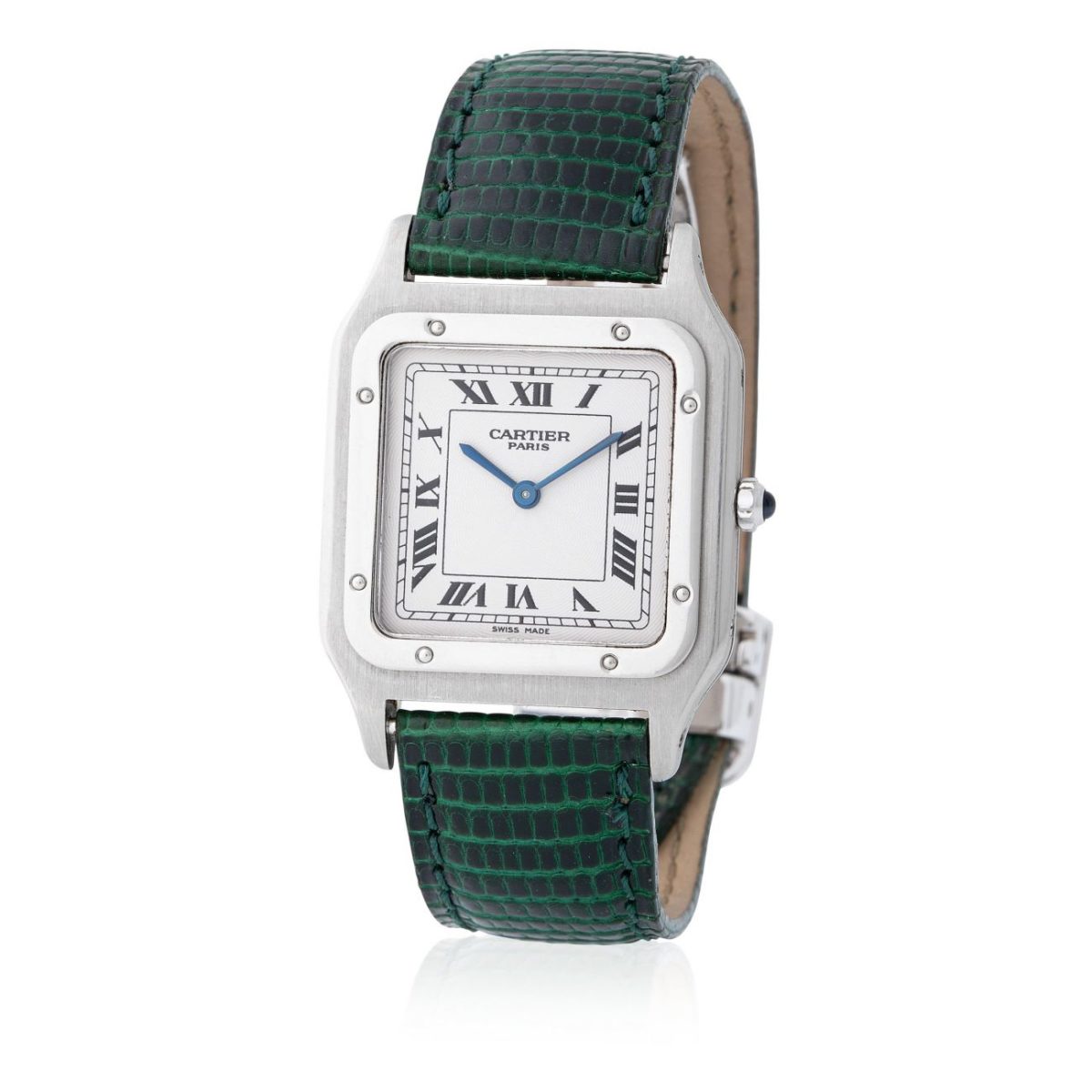
Like all good stories, we have to start at the beginning. The first wristwatch ever made, not just by Cartier, but by any watch manufacturer, was the Cartier Santos watch. Remember, before the 20th century, wristwatches were thought of as feminine, with the gentlemen of the day choosing to wear pocket watches. But when, in 1904, Brazilian aviator Alberto Santos-Dumont asked his friend Louis Cartier to make him a watch. Specifically, a watch he could read without taking his hands off the controls of his prototype aircraft, and the Cartier Santos was born.
The Cartier Santos watch can be recognised by the polished bezel that stands out against the brushed case, complete with eight screws or pins that attaches the bezel to the case. The Santos watch also features the iconic square dial, made famous by the black Roman numerals that align with the heat-blued sword hands. This example is the reference 1575 and was made during the 1990s, inspired by the original design that was first drawn nearly a century earlier. The case is platinum, with dimensions of 27mm by 36mm, making it a modestly sized watch by modern standards.
Estimate: €8,000 – 16,000 (AU$12,880 – AU$25,750)
Result: €14,300 (AU$22,363)
Cartier Tank
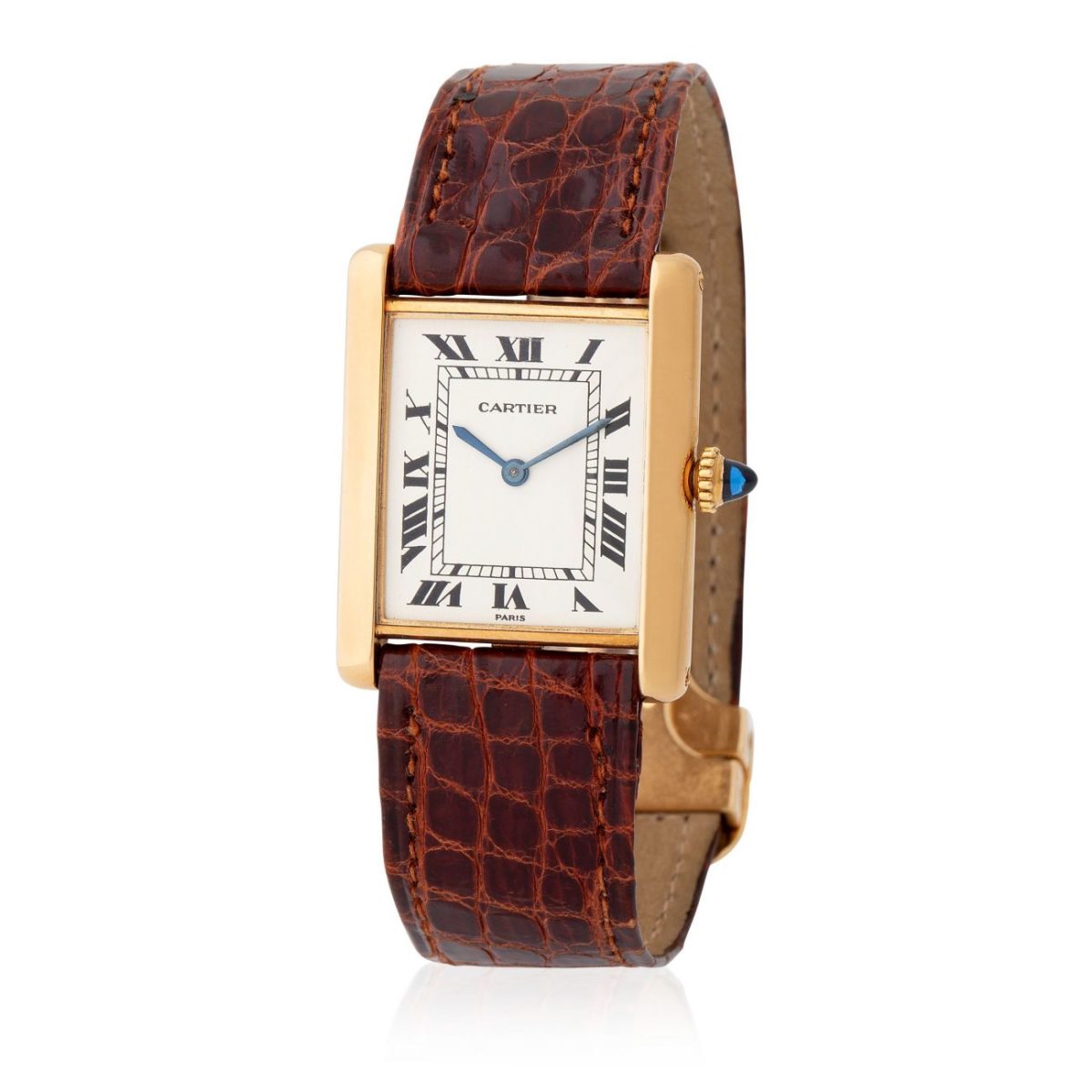
Without a doubt, the Cartier Tank is one of the most recognisable wristwatches that has ever been made. The iconic design is said to have been inspired by the Renault military tanks, which Louis Cartier saw in 1917 from the second-story window of his workshop, as they rolled through Paris during the First World War. From a birds-eye view, you can easily imagine the tracks on either side of the tank forming the elongated flanks of Cartier’s watch, forever infusing the design with an Art Deco flavour.
The Cartier Tank can be recognised as one of the most straightforward of the Cartier watches in terms of its design, featuring a white rectangular dial with black Roman numerals that contrast tastefully with the yellow gold case. Another important element of the design is the sapphire cabochon crown, which protrudes more heavily than the crown of the Cartier Santos.
This example features an 18k yellow gold case, a manually wound mechanical movement, and a matching 18k yellow gold folding clasp to secure the watch to your wrist. Produced in the 1970s, this example is a quintessential embodiment of the Cartier watch’s design DNA, and one of the all-time classic designs in watchmaking.
Estimate: €4,000 – 8,000 (AU$6,440 – AU$12,880)
Result: €8,450 (AU$13,214)
Cartier Tank Cintrée

Thanks to its effortless simplicity, the Cartier Tank was a design that was ripe for adaptation. One of the earliest tweaks to its design was the Cartier Tank Cintrée, a boldly elongated wristwatch that was first produced in 1921. The Tank Cintrée can be immediately recognised by its elegantly curved case, designed to comfortably follow the contour of your wrist while offering more of an impression than a standard Cartier Tank. Another point of variation in the Tank Cintrée is the blued steel Breguet hands, emphasised by the small circle they form just before their tips.
This specific example was made in the 1940s, during the unofficial golden age of wristwatches, and remains in very good condition for its age. Featuring a gently curved yellow gold case that measures 18mm by 35mm, the watch is powered by a manual wound movement made by the European Watch and Clock Company. If you can’t have a collection dedicated to vintage Cartier watches, this could be your one and only.
Estimate: €30,000 – 60,000 (AU$48,280 – AU$96,560)
Result: €52,000 (AU$81,322)
Cartier Crash

If you needed any further evidence of the incredibly dynamic designs of Cartier watches, you need only look at the Cartier Crash. The misshapen, almost Dali-esque, quality of the yellow gold case is the stuff of watchmaking legend. As the story goes, in the 1960s a Cartier Tank was returned to the Cartier boutique in London, seeking repair after it was badly damaged in a car crash. The case of the damaged watch was apparently the source of inspiration for the Cartier Crash collection, despite the brand never confirming the details of the story.
Regardless of its mysterious origins, the Cartier Crash was the perfect example of the cultural vibrance that was felt in London at the time, representing a less traditional buyer of luxury goods. Even today, the Cartier Crash represents an elevated and refined level of taste in luxury watches, worn by the trailblazing likes of Kanye West and Tyler The Creator. The asymmetrical case of this example measures 20mm by 38mm of yellow gold and is powered by a manually wound movement. Produced in 1991, this Cartier watch is one of 400 pieces that were made in a limited edition release.
Estimate: €50,000 – 100,000 (AU$80,460 – AU$160,920)
Result: €201,500 (AU$315,125)
Cartier Tonneau

Arriving at the Cartier Tonneau, and we have another elegantly elongated expression of the Tank, also first conceived in the early 20th century. Similar to the Tank Cintrée in its curvature and case length, the Tonneau features curved rather than straight case sides. With curved case flanks and straight lines across the top and bottom of the case, the Tonneau looks like a barrel, which is actually the French translation of the word tonneau.
The larger 18k gold case size, measuring 46mm in length and 26mm wide, allows for a more expansive dial in this Cartier watch. In this specific example, the dial features a subtly engraved floral motif that radiates out from the centre, almost imperceptible without a close examination. Just like the Santos and the Tank, the Tonneau features blued steel sword hands, matching the sapphire cabochon in the crown. This example is powered by a manually wound movement and was produced in the 1990s.
Estimate: €5,000 – 10,000 (AU$8,030 – AU$16,060)
Result: €8,450 (AU$13,214)
Cartier Tank Asymmetric

Cartier’s sophisticated understanding of proportions can be seen in the sheer number of different shapes that the brand worked with. The Cartier Tank Asymmetric from 1936 features a parallelogram-shaped case, where the dial is arranged in a diamond shape. This sloped expression of the Tank is designed to be easier to read, with a dial angled towards the owner when worn on the left wrist. Such an elegantly simple twist on an already sparse design speaks to the dynamic creativity and discipline that Cartier went about his work with.
This example is in platinum, with a watch case that measures 25mm by 34mm, and features a matching platinum folding clasp. This specific example is number 5 of a 100-piece limited edition that was produced in 1996, features a stunning guilloché silver “à rayons de soleil” dial, and is powered by the manually wound 9P2 calibre.
Estimate: €25,000 – 50,000 (AU$40,150 – AU$80,300)
Result: €74,100 (AU$115,884)
Cartier Tank À Guichet

While the inspiration of the World War I Renault tank is immediately clear in the design of the original Tank, the Cartier Tank À Guichet offers even more of a resemblance. Featuring a more angular case design than the first Tank, you’ll also notice the undeniably charming jumping hour way of telling the time. Jump-hour watches were tremendously popular in the 1920s and 30s, offering a digital display of the time via two windows, with hours at the top and minutes below. The French translation of window is guichet, which is what Cartier decided to name the watch after.
This example features a brushed platinum case, with a beautifully made and relatively unusual bracelet made in the same precious metals. Also unusual is a red ruby set crown, rather than the traditional blue sapphire cabochon. While the brand hasn’t been particularly consistent with when they use rubies or sapphires in Cartier watches, in more recent years a ruby set crown will indicate the case metal is platinum. This example was produced in 1997 to celebrate the 150th anniversary of the Cartier firm and is one of just 150 pieces that were made.
Estimate: €50,000 – 100,000 (AU$80,460 – AU$160,920)
Result: €120,250 (AU$188,058)
Cartier Tank Basculante

Today, when you talk about reversible watches, you’ll be talking about the Jaeger-LeCoultre Reverso. But while the horizontally flipping case of the Reverso is a verified Art Deco icon, Cartier had their own version produced in the 1940s. The Cartier Tank Basculante is another creative interpretation of the original Tank, featuring a mechanism that allows you to reverse the case and protect the dial if the need ever arose. Because of the vertical direction the Tank Basculante flips, the crown is carefully concealed at the 6 o’clock position.

This example features a yellow gold case that measures 19mm wide and 38mm long, perfectly embodying the elongated rectangles that can be seen throughout the Art Deco design movement. Curiously, the dial features black Roman numerals but doesn’t feature the Cartier signature, while the watch is powered by a manually wound European Watch and Clock Company movement.
Estimate: €25,000 – 50,000 (AU$40,150 – AU$80,300)
Result: Unsold
Cartier Pasha

If you think Cartier watches are just variations on the Tank, think again. The Cartier Pasha offers a glimpse into an entirely different design language, dominated by opulent curves, architectural lugs, and a unique crown mechanism. The Cartier Pasha was first produced in 1933, reportedly at the explicit request of a sultan of Marrakech, who as the story goes, needed a waterproof watch to wear while he was in the bath. There is little evidence of this, but it certainly adds to the mysterious legend of the Pasha.
Featuring a 38mm yellow gold case, the defining feature of this Cartier Pasha is the oversized waterproof crown protector. Once you unscrew the sapphire cabochon-set outer crown, you’ll find a smaller functional crown from which you can set and wind the watch. For practicality, the crown protector is attached to the case via a small gold link, building on the exotic theme of the watch. This example was produced in 1986 and is an automatic watch, powered by the 2824-2 calibre.
Estimate: €4,000 – 8,000 (AU$6,440 – AU$12,880)
Result: €6,500 (AU$10,165)
Cartier Mystery

The enigmatic creativity of Cartier watch design can be seen in all of the watches it produced, but perhaps none more than the Cartier Mystery. Cartier is famous for producing dozens of Haute Horlogerie Mystery Clocks during the 1920s, which were directly inspired by the work of the French watchmaker and illusionist Jean-Eugène Robert-Houdin. It was Robert-Houdin who also inspired the American magician Ehrich Weiss to use the stage name, Harry Houdini. The Mystery Clocks were designed to disguise their inner workings, using glass and crystal to mask their structure.
The Cartier Mystery is a shrunk-down version of these Mystery Clocks, with this example featuring a 30mm pink gold case with a transparent dial, and hands that appear to be floating. In fact, the dial is made from a circular disc of clean transparent crystal, which holds the tiny mechanical movement in a hole at its centre. This example was made in the 1960s, has black enamel hour markers around the circumference of the case, and is powered by a Le Coultre movement.
Estimate: €4,000 – 8,000 (AU$6,440 – AU$12,880)
Result: €8,450 (AU$13,214)
Cartier Tortue Chronograph
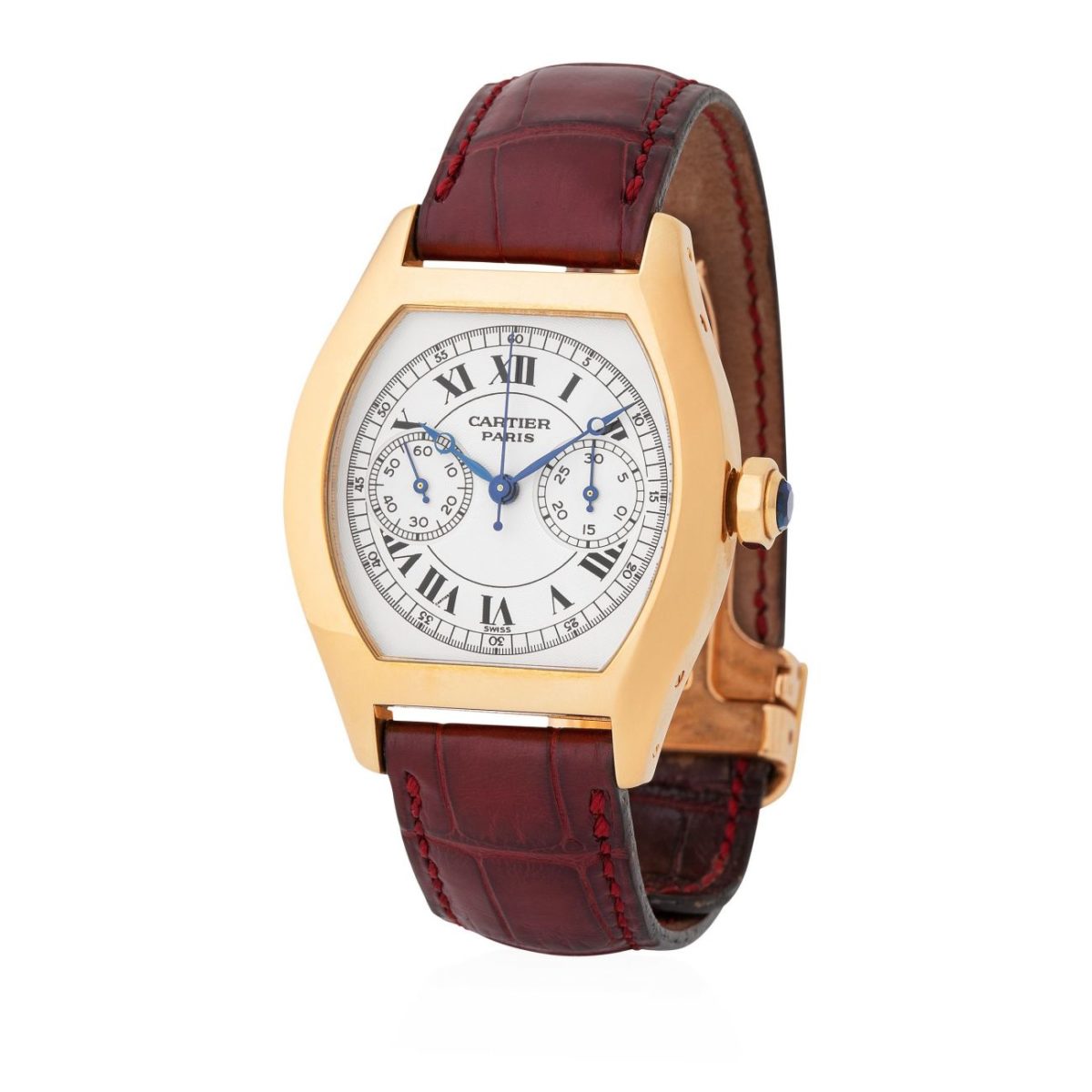
The Cartier Tortue features a slightly more portly interpretation of the tonneau case shape, less elongated and refined than the Cartier Tonneau design. The Tortue design was born in 1912, and was given its name for its resemblance to a turtle, and more specifically, “tortue à pattes” or “turtle on legs”. The Tortue can be found in a number of different Cartier models, however the most interesting of those is the Cartier Tortue Chronograph Ref. 2356.
This is one of the more contemporary of the Cartier watch designs, demonstrated in its thoroughly modern yellow gold case size of 34mm wide by 43mm in length and produced in the 2000s. The manually wound 045MC calibre is visible through the exhibition caseback of the watch and offers full chronograph functionality simply by pressing the crown. Despite its comparative youth, the Cartier Tortue Chronograph feels very true to the original Cartier watch design DNA.
Estimate: €15,000 – 30,000 (AU$24,100 – AU$48,200)
Result: €39,000 (AU$60,992)
Cartier Tank Obus

Originally produced in 1929, the Cartier Tank Obus offered a refreshingly square alternative to the original Cartier Tank and its rectangular variations. However, rather than the typical Cartier case which offers a shaped frame for the dial, the dial forms a part of the case with vivid blue champlevè enamel Roman numerals around its circumference. For such a simple design, the statement is a bold one, with the Roman numerals dominating the immediate visual impression, spectacularly framing the simple dial.
This example features a 25mm yellow gold case, which would wear slightly larger thanks to the unusual bullet-shaped lugs at each end of the case. Produced in the 1980s, this Cartier Tank Obus is powered by a quartz movement, allowing it to remain wafer-thin. As we’ve come to expect from Cartier watches, bold designs can arrive in the simplest packages.
Estimate: €5,000 – 10,000 (AU$8,030 – AU$16,060)
Result: €9,100 (AU$14,231)
Cartier Cloche

Within the world of weird and wonderful Cartier watch designs, the Cartier Cloche stands out as one of the most interesting. The asymmetrical case shape was first seen in Cartier watch design in the 1920s, which when flipped horizontally, forms the shape of a bell, or in French: cloche. Similar to the Cartier Tank Asymmetric, but more severe in its angle, the Cloche is also designed to be easier to read while your arm is in front of you.
This example in yellow gold was produced as a limited edition of 200 pieces in the 1990s and features a case with dimensions of 25mm by 43mm. The dial is engraved with an intricate guillochè pattern that is only interrupted by the printed Arabic numerals on the dial, and the blued steel Breguet hands, similar to the Tank Cintrée.
Estimate: €12,000 – 25,000 (AU$19,280 – AU$40,170)
Result: €40,300 (AU$63,025)
Cartier Baignoire Allongée
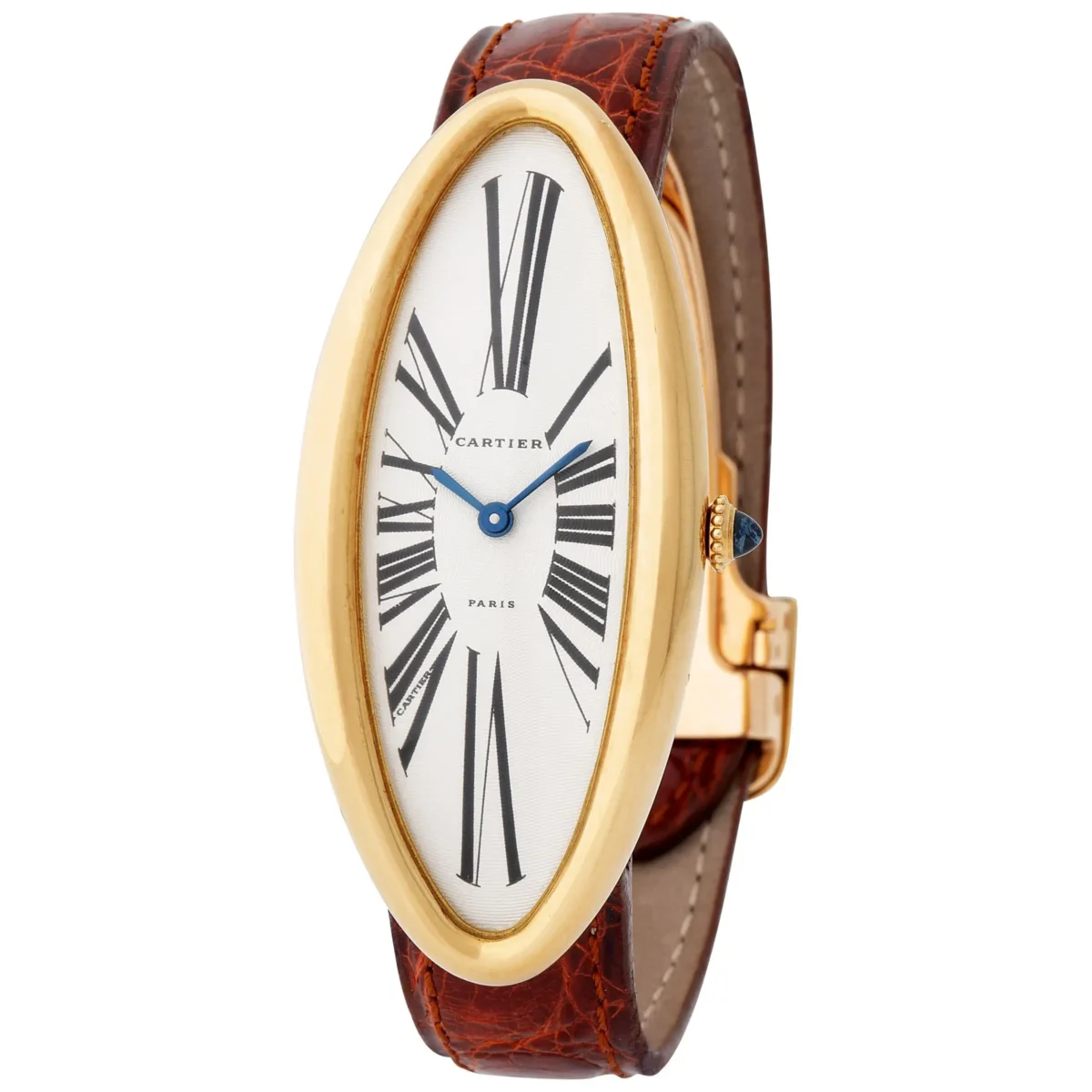
As its name suggests, the Cartier Baignoire Allongée is an elongated interpretation of the classic Baignoire watch that was popular in the late 60s with the likes of The Beatles member George Harrison. In true Cartier style and much like the quintessential Tank watch, the very first Baignoire from 1957 shares its name with the French word for bathtub, which one of the Cartier designers must have viewed from the top and was inspired by its shape.
While there was another, older Cartier Baignoire Allongée in the sale, this yellow gold example from 1991 is a very fine example of what to look for if you’re in the market for this model. Powered by a manual winding calibre 78-1 movement, it measures 24mm in width and 52mm in length and was a limited edition of just 400 pieces, making it all the more special.
Estimate: €12,000 – 25,000 (AU$18,766 – AU$39,079)
Result: €32,500 (AU$50,826)
Frequently Asked Questions – Best Vintage Cartier Watches
Which Cartier watch is the most classic?
Without a doubt, the most classic Cartier watch is the Cartier Tank, which has been in existence since 1918.
Are vintage Cartier watches a good investment?
Approaching any watches from the perspective of investment is a risky move, but there are a number of Cartier watches that have appreciated in value over time, such as the Cartier Crash, Cartier Pebble and more.
Is Cartier as prestigious as Rolex?
Cartier had been creating jewellery and watches for the royal families of Europe for more than half a century before Rolex existed, arguably making Cartier more prestigious than Rolex over history. Today, a number of Rolex watches sell over their retail prices, but it’s important not to confuse hype with prestige.
